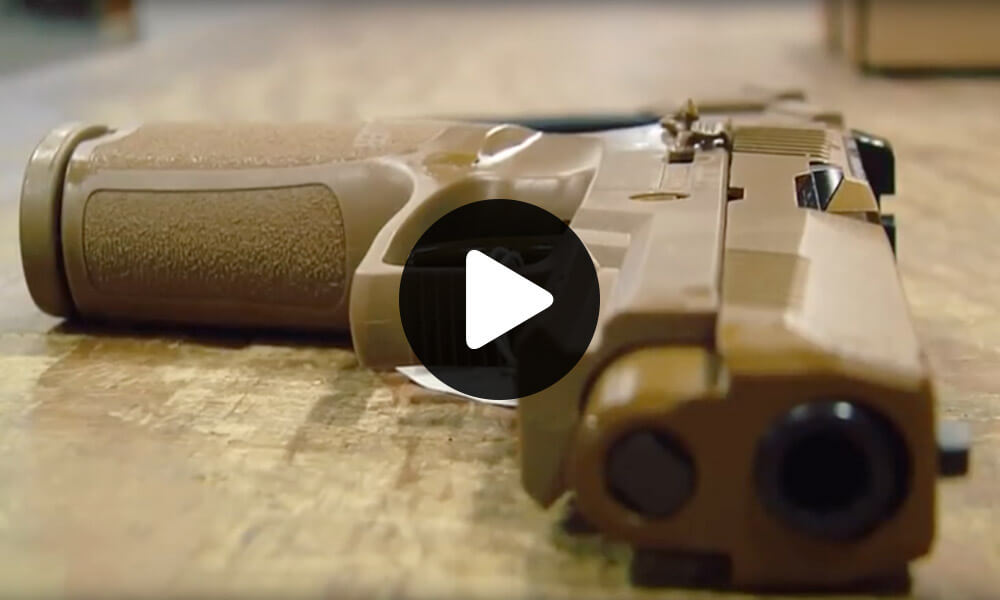During the Cold War, the United States Army introduced the Beretta M9 as the Army’s newest handgun. In the three decades since, the M9 has been used in the Gulf War, Somalia, Iraq and Afghanistan conflicts. Today, as the Army continues to evolve its equipment and technology, defense industry product developer Sig Sauer is launching a new Modular Handgun System (MHS) that is poised to offer advanced handgun capabilities to U.S. Soldiers.
This change may have, in part, come about in response to longtime, in-the-field shortcomings of the M9 as noted by military personnel. According to a joint survey conducted by the Center for Naval Analyses in 2006, only 58 percent of individuals who used the M9 were satisfied with its performance. This was the lowest satisfaction rate among all the weapons that were analyzed in the survey. Among the complaints voiced by service members was the weapon’s lack of ability to accommodate attachments and the M9’s lack of stopping power. Additionally, almost half of those surveyed expressed a lack of confidence in the weapon’s reliability. Service members also expressed concern regarding the difficulty of the maintenance associated with the M9.
In August of 2015, the U.S. Army held a long-awaited competition to determine the Service’s new sidearm. The Army’s competition demanded a modular system. This modular handgun would allow service members the ability to more easily add their desired attachments. Several other requirements were imposed to ensure that the new firearm would be a notable improvement over the M9. No specific caliber was required for the sidearm; however, manufacturers were notified that their firearm would be compared in a ballistics test with the current 9 mm round.

Additional preference was given to firearms that could be chambered in multiple sizes. The Army also expressed a desire for the handgun to be simple to clean and maintain, and consistently accurate and reliable. The M9 had previous issues with failures to feed, jams and other stoppages. With this in mind, the Army requested that entrants in the MHS competition experience 2,000 rounds between stoppages and 10,000 rounds between failures.

Twelve pistol manufacturers entered the competition, including global powerhouses such as Smith & Wesson, Glock, Kriss, FN Herstal and Sig Sauer. After a year of lab testing and consideration, Sig Sauer was awarded the $580 million contract to produce the Army’s new sidearm. The contract includes production of both compact and full-sized models of the Sig Sauer P320.
The P320, referred to by the Army as the M17 in its full size and as the M18 in its compact size, can be chambered in multiple calibers – including 9 mm, .357 SIG, .40 S&W and .45 ACP. This variety of compatible rounds serves to address the concerns regarding the stopping power of the sidearm.
In addition to accommodating various calibers, the new MHS also has an external safety, self-illuminating sights for low-light conditions, an integrated rail for attaching enablers, an Army standard suppressor conversion kit to attach an acoustic/flash suppressor and interchangeable grips.

The Army will also be acquiring the full metal jacket, special-purpose, close-combat mission capability kit and blank ammunition.
According to officials at Program Executive Office Soldier, the specific performance improvements from MHS over the M9 include better accuracy, tighter dispersion and better ergonomics, which combined result in a far more lethal pistol.
Extensive field testing of the new system took place across 2017. After incorporating Soldier feedback into the final design, the MHS was approved to move on to the next phase of testing.
In November 2017, the 101st Airborne Division became the first unit to receive the new M17 and M18 sidearms. The Soldiers had good things to say about the new firearm, especially in comparison to the M9. As reported by the Army, many comments from Soldiers noted the ease of use, simplicity and increased accuracy.

Reportedly, the Army plans to field the new MHS even more widely than its M9 predecessor with issuance going as far as the team leader level – the goal being to enhance the close-quarters’ capabilities of Soldiers, especially while performing administrative tasks that make rifle use difficult.
Current plans call for expedited fielding, taking place across 2018 and 2019. The MHS is currently in limited production, with the first 4,649 handguns already issued to units at Fort Campbell, Kentucky (where the 101st is based); Fort Benning, Georgia; and Fort Hood, Texas, in November, December and January respectively.
Full-rate production is scheduled to begin by mid-to-late 2018. Fielding of the MHS to all units will take place over the next 10 years, with ammunition being procured in the first five years.
According to the Army, the MHS program is the first in a line of modernization efforts that it will pursue over the next few years. In a released statement, Army officials described the MHS as, “A more capable weapon system that is aligned with the planned force structure and emerging operational needs of the Army. It provides improved lethality, target acquisition, ergonomics, reliability, durability and maintainability.”
By Staff Writer Liam Griffin




